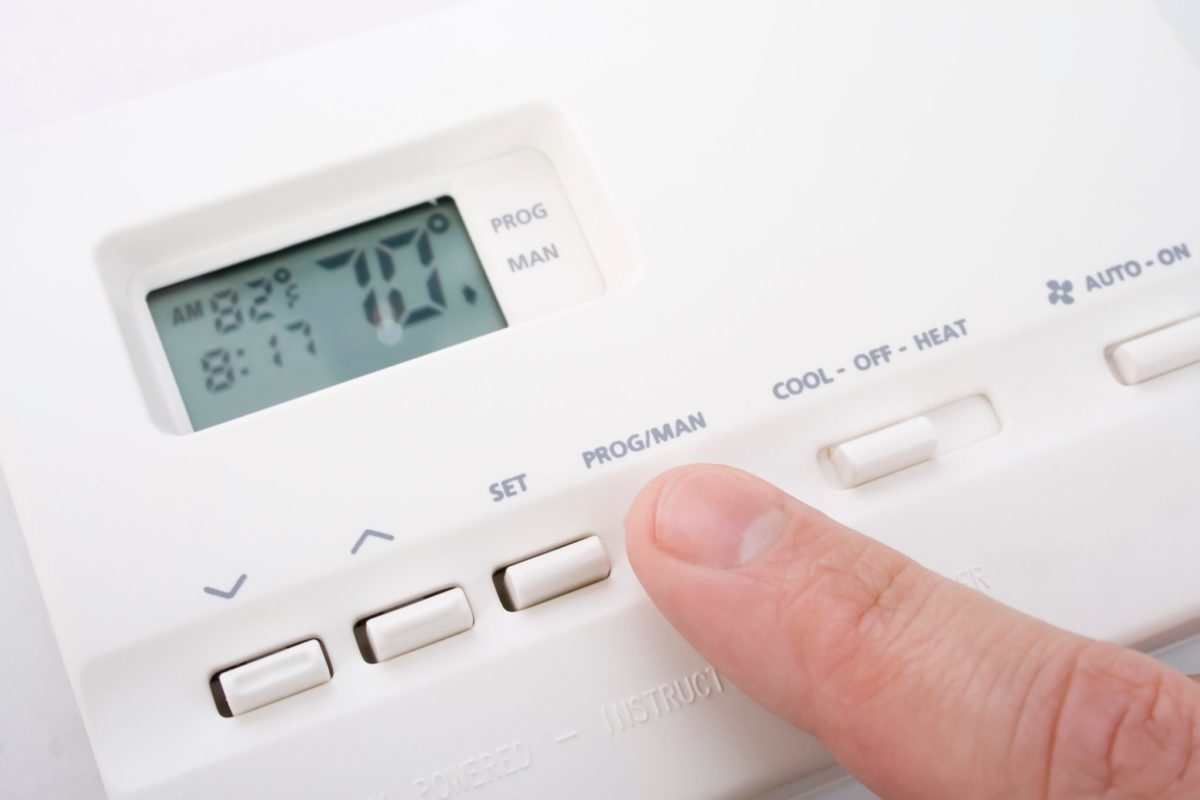
Thermostats are efficient if appropriately used to heat and cool your home. Thermostat settings can be confusing if you’re unsure which settings to use, which can be why the thermostat is not reaching set temperatures.
That’s why we’re here to assist you in understanding and navigating these settings. We will provide a step-by-step guide on adjusting your thermostat in situations, ensuring that your home maintains a comfortable temperature while optimizing energy efficiency.
Thermostat
Your digital thermostat maintains your home’s comfort. It displays two distinct temperatures:
- Ambient temperature inside your home
- Desired temperature
The ambient reading is the current temperature of your home. This gives you an idea of the existing conditions inside your dwelling. On the other hand, the desired temperature reading is the preferred temperature, which you can adjust when your thermostat is set to ‘auto’ or ‘run’ mode.
Thermostat Auto Mode 
Your thermostat ‘auto’ mode on will likely be the setting you use most frequently. It’s designed to balance your preferred temperature and the actual temperature within your home.
Imagine it’s summertime. You set your thermostat to 68 degrees. When the thermostat is in auto mode, it monitors the room temperature continuously. If it senses that the actual room temperature has risen above your set of 68 degrees, it automatically activates your air conditioning system. The cooling system will then operate until it brings the room temperature down to match your desired setting.
What Does Hold Mean on a Thermostat?
Your thermostat’s ‘hold’ feature lets you easily adjust and manage your heating and cooling preferences. It proves handy when your daily schedule diverges from the routine.
When you put your thermostat in “hold” mode, it switches back to auto mode, which lets you manually adjust the temperature to match your preference. This feature is useful when your schedule changes unexpectedly and you need different temperature settings than your pre-programmed ones.
For instance, if you’re home on a day you’d typically be at work, you might want the house warmer or cooler than your regular programmed setting. By putting your thermostat in hold mode, you can easily alter the temperature to suit your needs for that specific time.
What Does Run Mean on a Thermostat?
The ‘run’ function of your thermostat is essential for maintaining the climate in your home, especially if you have a programmable thermostat. These thermostats allow you to personalize temperature settings for times and days, which helps save energy.
When you have programmed temperature preferences on your thermostat, the ‘run’ mode brings those settings into action. Unlike the ‘auto’ mode that adjusts your home temperature based on the desired temperature you set, the ‘run’ mode enables your thermostat to operate according to pre-programmed temperatures.
For example, you may desire a temperature in your home while sleeping but a slightly warmer one upon waking up. By utilizing the ‘run’ mode, your thermostat will autonomously adapt the temperature according to your set preferences, guaranteeing maximum comfort.

Thermostat Settings for the Summer
During the summer months, it can be quite a challenge to strike a balance between keeping your home comfortable and energy efficient. Setting your thermostat between 72- and 76-degrees Fahrenheit when you’re at home is ideal. This temperature ensures that you stay comfortable while also being mindful of conserving energy.
If you’re going to be away, increase the temperature or turn it off completely. There’s no need to keep your house cool when nobody is around. This approach can help you save energy.
To simplify the management of temperature adjustments, consider utilizing a programmable thermostat.
These convenient devices enable you to schedule temperature changes based on your routine. For example, you can program the thermostat to initiate cooling your living space before arrival, ensuring you enter a soothing atmosphere.
A programmable thermostat offers these benefits:
- Takes away the inconvenience of changing your temperature settings
- Helps guarantee that your home’s temperature is consistently adjusted for comfort
- Enhanced energy efficiency.
Thermostat Settings for the Winter
Maintaining an energy-efficient home during the chilly winter months requires strategic thermostat management. The optimal thermostat setting for the winter is 68 degrees Fahrenheit when you’re at home, both during the day and at night. This temperature provides a balance of comfort and energy conservation.
However, if you’re going to be away from home or sleeping, the recommended thermostat setting is at the lowest 60 degrees for additional cost savings. This practice can significantly reduce your heating costs without impacting your comfort because you won’t be home or awake to the lower temperatures.
Thermostat Modes
Understanding your thermostat’s modes and settings can significantly enhance your comfort and energy efficiency at home. However, if you need help navigating these settings or have any questions regarding their optimal use, feel free to reach out to us here at A-Absolute Plumbing for professional guidance.
Take the guesswork out of managing your home’s climate. Schedule an appointment with us today. The A-Absolute team of experts is ready to help you understand and optimize your thermostat settings for each season.


